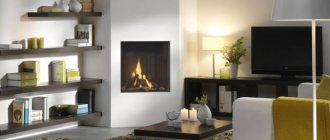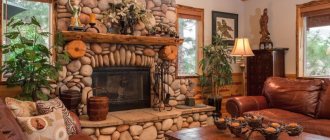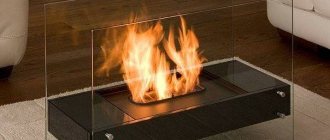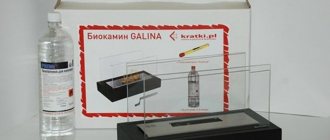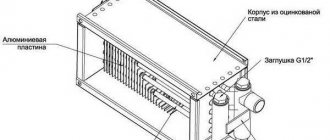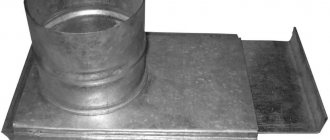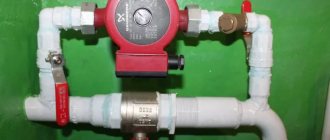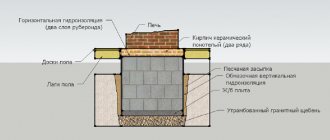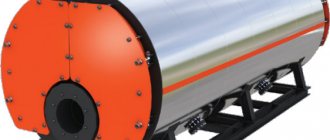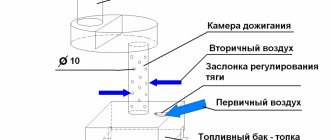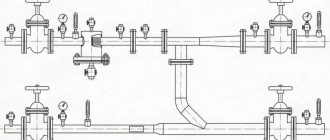Description, operating principle, fuel
What is a biofireplace?
A biofireplace is a modern and safe interpretation of a fireplace without a chimney, which can be used in almost any room, which is undoubtedly an advantage.
How does it work? The biofireplace runs on biofuel, which consists of biological raw materials, and the combustion products are no more harmful than those from a paraffin candle. Externally, a biofireplace can resemble the classic version or be a modern design that will decorate a fashionable interior.
The photo shows a stylish living room combined with a dining area. A double-sided fireplace not only performs a decorative function, but also helps to zone the space of the apartment.
Operating principle
The principle of operation is quite simple. Fuel is poured into the fuel tank and ignited with a lighter. To get fire, these two actions are quite enough. For safety and slow evaporation of fuel, ceramic wool is used.
Fuel for biofireplace
The fuel is technical alcohol. The consistency can be different, for example gel or liquid. To obtain biogel, alcohol, water, thickener and salt are added to the composition. The liquid form of fuel is obtained by processing agricultural crops.
Fuel consumption is quite economical, on average 0.5 liters per hour and a half of operation. But consumption may vary depending on the features of the selected model. The combustion temperature of the flame itself depends on the selected fuel, on average it is 400-600 degrees.
Does the bio-fireplace heat, heat transfer?
Biofireplaces, in addition to aesthetic pleasure, also provide warmth. The heat output of different models differs, starting from 1 kW and can reach 10 kW. In terms of heat production, a biofireplace can be compared to an electric heater. Small fireplaces most often do not have a heating function.
Do you need an outlet?
There is no need for electricity to operate. A natural flame is formed during the combustion of fuel.
Requirements for the room in which the biofireplace is installed
The biofireplace does not have any special requirements for placement, however, basic precautions must still be observed.
- The room in which the bio-fireplace is installed should be well ventilated, but not have strong drafts, just like fans and air conditioners.
- The distance from any interior items should be at least a meter, and from flammable objects such as paper or textiles, at least one and a half meters.
The photo shows a minimalist living room decorated in black and white and a long bio-fireplace.
Traditional, automatic and semi-automatic
The difference between traditional, automatic and semi-automatic biofireplaces is in control technology.
- A traditional, or in other words, mechanical fireplace is lit manually, using matches or a lighter.
- The automatic fireplace is controlled remotely by phone, tablet or remote control.
- The semi-automatic model begins and ends its work after a command given through the control panel located on the fireplace itself.
Open and closed
The difference between open and closed type is in the design of the fuel tank. The open type allows you to see the amount of liquid inside, while the closed type “hides” the firebox inside the structure box.
What to look for when choosing a fireplace
When choosing a biofireplace, pay attention to its design. The seams must be of high quality, and the body must be free of dents and damage. The protective door must be made of heavy-duty, fire-resistant glass. But the most important thing about a biofireplace is its warm “heart”. The thicker the walls of the heating tank, the longer it will last. High-quality containers are made of stainless steel. You will also have to decide on the control system. Some will prefer the mechanics with manual adjustment of the fire intensity, while others will not be able to do without “smart” automation with a set of buttons on the control panel.
Stylistic direction
Biofireplaces are universal. Absolutely any interior style will accept this element into the decor. Although some models, of course, are combined with specific design trends. For Provence and rustic style, bio-fireplaces with wood trim are suitable. The body made of decorative stone is organically combined with the classical and colonial trends, art nouveau. Glass models are suitable for modern, Scandinavian style and eco-friendly interiors. The body, decorated with imitation brick, will highlight the masonry on the accent wall in the loft. No Alpine chalet, country or Russian style would be complete without a bio-fireplace. Even restrained art deco and strict modern could benefit from a “fiery” addition.
Case materials and design
Based on body materials, biofireplaces are classified into the following types:
- Glass. The most popular option due to the special aesthetics of transparent walls.
- Ceramic. It has a pleasant glossy surface, which is most often combined with glass.
- Marble. The body is made of natural stone or its imitation. In the first case, the model will have an impressive weight, which will make it difficult to move and affect mobility. The use of decorative stone is completely justified, because overheating of the surface is not dangerous.
- Wood. The wood body has a particularly “cozy” look and fits into the eco-style “related” to the unit. In the original models, it has the shape of logs stacked in the hearth.
- Metal. Durable, reliable material, combined with strict styles.
- With a plasterboard portal. Such models are considered the cheapest, because their price, although biting, is not so much. Drywall is often used to decorate the body in cases where a biofireplace is built independently from scrap materials.
- Brick. The models fit into the concepts of loft and modern style. Such a body will echo a wall decorated with brick or stone masonry.
There are also combined options where several materials are combined at once. Glass appears in almost every model, since the front protective door is traditionally made of it.
Variety of shapes
Biofireplaces are made in a wide variety of forms: from classic to complex asymmetrical geometry. Depending on this characteristic, they are classified into the following types:
- Round and oval. The non-standard form of execution will attract attention. Such a fireplace will become the interior center of the room. Typically, wall-mounted and floor-standing models have rounded “sides.”
- Square. The shape, traditional for ordinary fireplaces, will blend into the interior created according to the principles of constructivism, minimalism and high-tech.
- Rectangular. Classic fireplaces that will appeal to conservatives who are skeptical about the new and extraordinary.
- Built-in. Static models that adapt to the characteristics of the location.
- Angular. The best option for small rooms.
- Asymmetrical. The variety of non-standard shapes will allow you to choose a unique option that will highlight the features of the author’s design of the room.
In the original models, the biofireplace burner is placed inside a vertically located ring, in the center of a curved metal tray or triangle, rhombus.
According to control technology
There are three types of control technology in biofireplaces:
- Machine. Ignition, extinguishing of fire and adjustment of its intensity are carried out remotely using a remote control. An ideal model for “lazy” people who prefer to place all the burden on equipment.
- Semi-automatic. Control is carried out using a button panel, which is located on the biofireplace itself. It differs from the machine only in the absence of a remote control, that is, to turn on the unit, you will have to approach it.
- Mechanics. You will have to light the fireplace with a match, and to extinguish it or adjust the flame, you will have to move the slide lid on the tank.
Mechanical models are among the cheapest, so they are suitable for those who need a budget option for an eco-friendly fireplace.
Types and diagrams of the burner device
Burners are classified into two types depending on the complexity of the device:
- Heating tanks. They are a set of a separate fuel tank with thick walls and the burner itself. The device is convenient in that combustion stops at any time when the flap is pulled back, which will hermetically close the fuel compartment. Heating tanks are more convenient to use and more expensive.
- Directly the burner itself without additional components. Such elements are most often made independently due to the simplicity of the design. They are an open tank into which fuel is poured. To ensure that there are several flames, it is covered with a special mesh with holes. The main drawback of the design is that combustion will not stop until the fuel liquid runs out. The intensity of the flame cannot be adjusted. But you can install several such burners and even supplement them with a bio-fireplace with a heating tank.
An important factor when choosing a unit will be fuel consumption. When using heating tanks, this figure is slightly lower than in simple burners, so from the point of view of economy, they are more profitable.
Requirements for the premises when installing a fireplace and operating rules
Although biofireplaces are not connected to the hood, which is convenient for city apartments, it is necessary to ventilate the room where they are installed. For rooms whose area exceeds 20-25 square meters, natural air exchange through open windows is sufficient. In small rooms, man-made ventilation is needed for regular air circulation, as carbon dioxide will accumulate in dangerous concentrations. Its excess negatively affects the human body and can lead to health problems. A pleasant and necessary addition would be to decorate the room with indoor plants in pots, which will “distill” it into oxygen.
When lighting a fireplace, the fuel may emit a specific “alcohol” odor, which dissipates very quickly. To avoid this, add a couple of drops of aromatic oil to the tank, which “will not spoil the porridge”
Operating rules
Despite the simplicity of the device, there are certain standards that increase the safety of using biofireplaces. In addition to the need to ventilate the room during work, there are additional rules:
- The distance between the bio-fireplace and other objects should not be less than 1 m. Synthetics, textiles, and paper should not be kept nearby.
- For ignition, do not use paper or matches, only a fireplace lighter; This task cannot be trusted to children.
- Bioethanol is poured immediately before use. The fuel compartment is not sealed and is not designed to store fuel, which immediately begins to erode.
- Do not add (or pour) biofuel into a hot device.
Design
How is the fireplace constructed? The design of the case can be almost anything, depending on personal preferences. The main requirement is compliance with safety rules, or rather the required minimum distance from the flame. The top of the flame should be at least 80 cm from the surface of the body, and the distance from the side should be at least 20-25 cm.
The right angle for your wall
Rare, but at the same time widely used by designers. The corner bio-fireplace allows you to observe it not only from the front, but also from the corner (left or right, it’s up to you). An ideal option for placing a corner fireplace when the living room and kitchen are combined. You have a view from both the sofa area and the kitchen area. By the way, here is one of our completed projects for a corner biofireplace with a length of 3500 mm!
Design project
Giant in a word
Example of a corner biofireplace
Look at our completed work go to our work section
Gorgeous views from three sides
These biofireplaces offer visibility from three sides. There are no walls to the left and right of the fireplace. The frames of these fireplaces can be either classic black or, for example, made of 3D panels (well, at least Kronco makes those). This option is suitable if you have visual access from these sides. If it doesn't exist, then you simply don't need it. Typically, such fireplaces are made across the entire width of the niche. A few examples for your attention
Classic front
An example of a frontal bio-fireplace with 3D panels and along the entire length of a niche
Zoning using a through fireplace
These models are rarely used, but practically every project where they are present lights up with new colors! Such fireplaces are mounted in partitions and here you have a view of the fire from two sides, usually from the living room and kitchen. Believe me, live it’s just something! By the way, we had a project with end-to-end, look at it here
An example of placing a through biofireplace.
Types and diagrams of burners
As for the description of the burners, they can be of several types and have different characteristics, but they all operate on the general principle, evaporative atmospheric. That is, the fuel evaporates in a heated chamber in the absence of air, and the vapors released into the atmosphere burn in the air.
For this operating principle, there are three types of burners:
- capillary,
- wick,
- gravity flow.
The capillary burner has a simple design, but there are a number of disadvantages. When starting up, you may smell ethanol; the filler in the burner tank becomes clogged over time and requires replacement, and it is also necessary to provide a barrier and adjust the flame height, since at the beginning of operation the fire burns hotter.
The wick burner is easier to use. Filling the container with fuel is done “by eye”. The flame of this type of burner is stable, without sudden changes, so a barrier is not required, except for various flame effects, but it is worth providing for the presence of a divider grille.
A gravity burner produces a stable flame during operation and does not emit vapors when warming up, since a supply of them is formed in the evaporator and this is enough to start. In addition, this type of burner can be produced in a round shape, provides long operation, up to 4 hours, and is also suitable for a fireplace of any power.
Let's sum it up
A biofireplace is a device that can bring an atmosphere of warmth, coziness and comfort into a room. Equipment developers strive to diversify the choice for the buyer as much as possible, offering a range of solutions for all occasions. The fireplace can be installed in any room, and there is no need to call a specialist or purchase a professional tool.
It is important to follow the instructions for using the device. This will eliminate the likelihood of a negative experience, prevent burns and discomfort from using the fireplace.
To understand how to choose a bio-fireplace correctly, you need to take into account its characteristics and the specifics of the room when selecting it. You can buy a biofireplace for yourself or as a gift to really dear people. A gift in the form of a small biofuel fireplace will be remembered for a long time, and will not gather dust on the shelf.
Advantages and disadvantages
A biofireplace, like any other device, has its advantages and disadvantages. It is worth noting the most significant of them.
Pros:
- The biofireplace is easy to install and operate;
- In addition to its decorative function in the interior, a biofireplace is an additional source of heat;
- Economical fuel consumption and low cost;
- Wide selection of models;
- Combustion products are not harmful to health.
Minuses:
- High cost, especially on models with automatic control;
- Open fire requires careful handling.
The photo shows a spacious living room in high-tech style. A freestanding floor-standing fireplace replaces the coffee table, and the flames can be seen from anywhere in the room.
Is biofireplace safe?
If you follow a few basic rules, the bio-fireplace will definitely not threaten the safety of your household. In addition to ventilating the room, it is also important to be careful when adding fuel to the firebox. Bioethanol can only be added when the fireplace is extinguished and cooled down. If the fire has already gone out and you want to relight it, you must wait until the fire goes out. Otherwise, when adding biofuel, you may get burned or cause a fire due to the unexpected explosion of flammable vapors. If bioethanol spills, you should wipe it up before lighting the fireplace.
To avoid putting yourself and your loved ones at risk, you should also choose good quality biofuel and store it properly. In particular, it is not recommended to purchase bioethanol that is not intended for combustion in a fireplace. This soot-producing mixture of ethanol and gasoline can also explode suddenly. Because biofuel is a flammable liquid, we must store it away from sources of fire and out of the reach of children and pets.
Kinds
Tabletop (portable)
Mobile design that can be easily moved to another room. This model produces a minimum of heat and has more of a decorative function in the interior of the room. Mini biofireplaces operate on replaceable cartridges.
Built into a niche in the wall
An interesting model can be built into one or two vertical planes, that is, a corner biofireplace. Visually, the structure looks like part of a wall.
The photo shows the interior of a cozy living room in white and gray. A rectangular bio-fireplace built into the wall fills the room with warmth.
Built into furniture
A fireplace built into the furniture takes up little space, but creates a feeling of coziness in the interior. A mini bio-fireplace can be built into a coffee table. As a rule, it is installed on a flat horizontal surface. The table is easy to move and will give uniqueness to the interior. Another design option is a fireplace built into the countertop or central part of the cabinet.
The photo shows the interior of a bright living room in a modern style. The bio-fireplace is built into the chest of drawers, the back wall of which is decorated with mirror inserts.
Wall
The narrow design does not take up much space and, depending on the design, will decorate the interior in a modern style. The wall-mounted model is fixed to the wall with 2 screws.
Floor
A biofireplace of this type can be considered not part of the interior design, but its main object. Unlike wall-mounted and built-in models, a floor-mounted biofireplace provides a full view of the hearth from any side. Floor-standing models are heavier, but just as portable.
Suspension
The bio-fireplace is attached to the ceiling. This model will look good in rooms with high ceilings and will decorate a modern interior.
In the portal
The bio-fireplace in the portal imitates a fireplace in the classical sense. The portal itself can be made of various materials and is of the wall type. The depth and width of the portal depends on the size of the fuel cassette.
The photo shows an interior in a classic style. The bio-fireplace is “recessed” into the portal, and the body is made of stone and plaster.
Angular
The corner model can be installed in the corner of the room, thereby using empty space. Another type of corner fireplace is installed on the walls, so it can decorate two rooms at once.
Round
A round or spherical biofireplace is suitable for modern interior design. A round fireplace will look good as a hanging, floor or tabletop model.
conclusions
Despite the apparent simplicity of the design and operation of a biofireplace, they can present a lot of unpleasant surprises to the uninitiated.
You can avoid them by purchasing a fireplace and biofuel for it in specialized stores, for example, from us. Having worked in this market segment for quite a long time, our specialists can tell you almost everything about the features of any fireplace brand.
The consultant will carefully listen to all your wishes, clarify where you plan to install the fireplace, in what mode to operate it, and offer a choice of several models that best meet the buyer’s needs.
We offer products from the world's leading brands, which guarantees you the quality of the product and a long period of use.
Materials, body design
Glass
The stylish design with glass will look harmonious in a modern interior. In addition, the glass gives a complete view of the flame. The body uses reliable heat-resistant glass.
Ceramic body
This type is most often used in the manufacture of small structures, such as a tabletop biofireplace. Ceramic matches the flame beautifully. The design of the body can also be made of ceramic tiles.
With a plasterboard portal
Plasterboard construction is a fairly economical design method. You can make the design yourself or purchase a ready-made one. The size, shape and finish can be almost any.
Marble body
A bio-fireplace in a marble casing is a luxurious and expensive piece of furniture. Natural marble or high-quality imitation will look perfect in any interior.
Wooden body
Wood is a beautiful and noble material. The design can be in classic, country or Provence style. The wood must be treated with a heat-resistant coating.
Video review
A biofireplace is a device that resembles a fireplace and is intended for installation in a city apartment. It usually uses ethyl alcohol or propane as fuel. The bio-fireplace does not need a hood – it is enough to ventilate the room after using it.
Today you can find a variety of models on the market - from budget to premium. You can buy a ready-made solution, or you can purchase a burner for independent integration into the interior. When choosing, you should pay attention to power, fuel tank capacity, material of manufacture, price and manufacturer.
Accessories and decor
Accessories and decorative elements will add ambiance and create the right atmosphere in the interior. It is worth remembering that the decor should not block the flame, but should be located around the fuel block.
Ceramic firewood, burnt logs
An integral part of the fireplace can be considered red-hot wood or stones; they enchant with their warmth and mesmerizing color. For a bio-fireplace you will have to exclude natural wood. It will be replaced by ceramic products, which are practically indistinguishable in color and texture from real wood. Ceramic firewood can imitate any species, most often pine or birch.
Imitation coals
Biofireplace coals are made of ceramics or glass ceramics. Visually, they are no different from the real ones and exactly repeat the shape and color.
Stones, pebbles
Natural pebbles or stone are used. The material is strong and heat resistant. For a more attractive appearance, the stones are polished and coated with the desired color. The fire is reflected especially beautifully on the varnished surface of the stone.
What are biofireplaces made of?
Several different materials are used to produce biofireplaces. The most common are glass, stainless steel, concrete, stone and MDF. This affects not only the appearance of the product, but also its durability. Many people do not know which biofireplace is recommended for reliability. The main thing is to choose a model with a heat-resistant case. Although it does not have direct contact with the fireplace, it should be designed to allow the fireplace to be used safely.
Photo in the interior of the apartment
Living room
A fireplace in the interior of the living room will envelop the room in special comfort and fill an ordinary evening with charm. Different variations of location and design allow you to choose the ideal option for your living room interior. For example, a floor-standing fireplace in a glass case for a modern style or in a portal with a marble frame for a classic one.
A big advantage of a bio-fireplace is the ability to use the space above the fireplace, for example, installing a TV above it. This design method is safe and looks impressive.
The photo shows a modern living room interior with a bio-fireplace built into the countertop.
Bedroom
A fire in the bedroom interior will help you relax and give you a romantic mood. For a spacious bedroom, you can use a built-in or floor-standing fireplace. For a compact room, desktop or built-in furniture models are suitable.
Kitchen
The fireplace in the kitchen interior is an unusual and original solution. It can be built into a wall, the end of an island, or serve as a room divider. Another design option would be a small tabletop fireplace that will decorate the dining area.
Loggia, balcony
A loggia or balcony will become a real lounge area, even with a small bio-fireplace. The interior will be complemented by a table and a pair of cozy chairs. On such a loggia it is pleasant to end the day under the warm glow of the fire.
Which company should you choose?
The following manufacturers of biofireplaces are especially popular in 2021-2022:
- Kratki is a Polish brand that produces reliable devices with a classic design. Production has existed for several decades and has gained great popularity in the world market.
- Silver Smith is a young brand that appeared in 2011. Produces affordable models with classic forging elements.
- Russian Fire is a domestic company that is distinguished by its reliable designs, high fire safety and various design options.
- ZeFire is another Russian company with five years of experience, but it competes well with famous foreign brands. It is distinguished by high-quality products and unusual design solutions.
Photo in a country house
A country house or cottage is an ideal place for a fireplace. The large area allows you to choose unusual and voluminous models, while eliminating unnecessary hassle during melting and maintenance.
The photo shows a cozy lounge area of a country house. The bio-fireplace is imitated as a wood fireplace.
Another original solution would be to install a fireplace outside, a couple of chairs opposite it and a cozy blanket will make an evening in the fresh air truly magical.
general information
| Name | Manufacturer | Cost of a popular model |
| Planika | Australia | 140000 |
| Kratki | Poland | from 6 300 |
| Kronco | Russia | 48000 |
| Silver Smith | Russia | 8900 |
| ZeFire | Russia | 32900 |
| Art Flame | Russia | 63000 |
| Safretti | Netherlands | 80000 |
| Bio-Blaze | Belgium | 19900 |
| BioKer | Russia | 11900 |
| GlammFire | Portugal | 752080 |
This is a list of the best manufacturers of biofireplaces for apartments and country houses, whose products are of high quality and reliability.
Presentation in different styles
Classical
The interior will be decorated with a bio-fireplace in a portal framed with a marble or plasterboard frame. Symmetrical shapes and straight lines will support the design concept.
Modern
There are many design ideas for a modern interior. A biofireplace will be an excellent solution for such trends as minimalism or hi-tech. A transparent glass, chrome or ceramic body will highlight the style features in the interior.
The photo shows a living room in a modern style, made in a warm palette. A small fireplace built into the wall decorates the interior.
Loft
The urban direction will be decorated with a bio-fireplace built into the wall or hanging. Fire will pair well with cold, raw concrete walls or brickwork.
The photo shows an interior in loft style. A small fireplace is located under the TV and takes up minimal space.
Provence
Gentle and romantic Provence will envelop the room in warmth with a bio-fireplace in a wooden, stone or plasterboard casing. The interior will be complemented by ceramic birch firewood and coals.
Steam electric fireplace
electric fireplace with steam
A little about biofireplaces with steam effect. This is a kind of decorative fireplace-air humidifier. Imitation of live fire is achieved through lighting. It is bright from below and weak from above, the water evaporates and the steam moves from bottom to top, creating a smoke effect. For such a fireplace, one outlet is not enough; you will have to periodically fill it with water.
Having considered the types of bio-fireplaces and electric ones, purchasing a bio-fireplace turns out to be more profitable and convenient, as it can be presented in a wide variety of shapes and sizes.
Myth No. 4. Living fire is a source of fires
The cause of a fire can be an unextinguished cigarette, a gas stove, or electrical wiring. To avoid accidents, keep a fire extinguisher at home and follow safety precautions when using the biofireplace.
By the way, we have an article “How not to use a bio-fireplace”, I recommend you read it.
